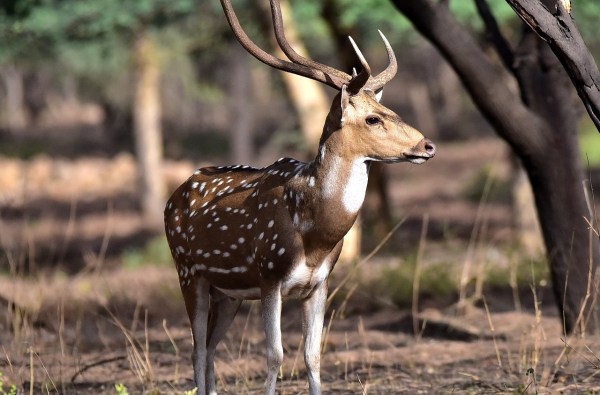Explained: India’s plan to bring cheetahs from Africa to Madhya Pradesh
70 years after the cheetah's extinction, the Indian government is planning to introduce them in the Kuno wildlife sanctuary.
 Three cheetah cubs come to greet their mother. Cheetah mothers have to be extra vigilant in order to protect their cubs. (Photo source: Kalyan Varma)
Three cheetah cubs come to greet their mother. Cheetah mothers have to be extra vigilant in order to protect their cubs. (Photo source: Kalyan Varma)India and Namibia signed a Memorandum of Understanding (MoU) on Wednesday to reintroduce the African cheetah in India. The MoU signed by Union Minister for Environment, Forests and Climate Change Bhupender Yadav and the Deputy Prime Minister and Foreign Minister of Namibia Netumbo Nandi-Ndaitwah, in New Delhi, also focuses on cooperation on wildlife conservation and sustainable biodiversity utilisation.
The Asiatic cheetah was declared extinct in India in 1952 and is a critically endangered species surviving only in Iran. In 1947, there were confirmed records of the cheetah’s presence in India, but the three surviving males were gunned down by Maharaja Ramanuj Pratap Singh Deo of Surguja state in what is now Guru Ghasidas National Park in Chhattisgarh.
In a tweet shortly after the MoU was signed, Yadav said, “The MoU aims to facilitate cheetah conservation in both countries by way of exchange of expertise, sharing of good practices in the field of wildlife conservation, use of technology and sustainable management of biodiversity.”
What is the government’s plan to bring cheetahs to India?
The Indian government has been attempting to reintroduce cheetahs in India since the 1960s and the 1970s, but over the past decade these plans have gained more momentum. Back then, the government attempted to bring Asiatic cheetahs from Iran because it was the only country to have a surviving population of the species, but Tehran had declined, in part because of the critically low population numbers of the species, all of which were in the wild.
Then in September 2009, during Jairam Ramesh’s tenure as environment minister, these plans gained traction when the minister pushed the project as one involving the reintroduction of “the only large mammal to have gone extinct in India.” Around that time, there was indication that the cheetahs would be brought in from the Cheetah Conservation Fund (CCF) in Namibia or other captive facilities based in South Africa.
What were the issues in this plan getting approved?
 Kuno Wildlife Sanctuary, in Madhya Pradesh. (Photo Credits: Amritanshu Singh, SDO, Kuno Wildlife Division)
Kuno Wildlife Sanctuary, in Madhya Pradesh. (Photo Credits: Amritanshu Singh, SDO, Kuno Wildlife Division)
While these developments were occurring, the government’s Asiatic Lion Reintroduction Project, an initiative involving the reintroduction of the last wild population of the Asiatic lion found in the Gir Forest National Park in Gujarat, was happening simultaneously. The project attempted to establish a new population of Asiatic lions at the Kuno Wildlife Sanctuary in Madhya Pradesh. But this proposed translocation was bitterly contested by the Gujarat state government, on several grounds, one of which was that the lions were icons of the state.
The dispute reached the Supreme Court of India, which in April 2013 threw a spanner in the works. In its order, the apex court said: “At this stage, in our view, the decision taken by MoEF (Ministry of Environment, Forest and Climate Change) for introduction of African cheetahs first to Kuno and then Asiatic lions, is arbitrary and illegal and clear violation of the statutory requirements provided under the Wildlife Protection Act. The order of MoEF to introduce African Cheetahs into Kuno cannot stand in the eye of Law and the same is quashed.” One of the grounds for quashing included the apex court’s objections to flying in a foreign species while ignoring the needs of native species.
But the Indian government was unwilling to drop its proposal. The government’s National Tiger Conservation Authority approached the court with a review petition in 2016, once again seeking permission to reintroduce cheetahs into Kuno. The government argued that the cheetahs would help in conservation of other species in the sanctuary, including that of the grasslands. The legal proceedings shed some light on the government’s plans, which included the possibility of introducing the African Cheetahs to other national parks and sanctuaries in the country.
What has the government said?
Yadav had tweeted that the reintroduction of the cheetah “in India has a larger goal of re-establishing ecological function in Indian grasslands that was lost due to extinction of Asiatic cheetah. This is in conformity with IUCN guidelines on conservation translocations.”
The first batch of eight cheetahs are expected to arrive from Namibia in August this year, comprising four male and four female cheetahs, the government said. After the MoU was signed, India’s Environment Ministry said: “The main goal of Cheetah reintroduction project in India is to establish viable cheetah metapopulation in India that allows the cheetah to perform its functional role as a top predator and provides space for the expansion of the cheetah within its historical range thereby contributing to its global conservation efforts.”
Conservationists and independent wildlife experts have long expressed concern about the government’s plans, but officials involved with the project have dismissed these concerns. Some of these concerns include the ability of the cheetahs to adapt to Kuno’s foreign environment and its ecological differences.
“There are temperature extremes in the country. While the vegetation is the same, we have higher rainfall than they have (in Namibia). They also have sub-zero temperatures which we don’t have here,” Amritanshu Singh, the Sub Divisional Officer of Kuno National Park’s wildlife division, who has been involved with the project, told indianexpress.com.
What has the Kuno sanctuary planned?
The initial release of the cheetahs will involve what the park calls a “soft release”, where the animals will be monitored within a 500-hectare, electrically-fenced area, that is regularly monitored by park staff.
Just before the cheetahs arrive, leopards in Kuno will be moved out of the territory demarcated for the cheetahs to prevent conflict between species. Among other concerns, conservationists critical of these reintroduction plans have also questioned whether the park has the capacity to adequately provide prey for the cheetahs.
 Spotted deer are present at the Kuno sanctuary as a food source for the cheetahs. (Photo Credit: Sanjay Dutt Sharma)
Spotted deer are present at the Kuno sanctuary as a food source for the cheetahs. (Photo Credit: Sanjay Dutt Sharma)
“We have plenty of food for them. We have 15,000 to 20,000 spotted deer, for instance in Kuno for them,” Singh said. “An indicator of the park’s carrying capacity of herbivores is the browse line, and we don’t have these lines in Kuno,” he said. A browse line is a distinct, horizontal line where the leaves of the lower branches of trees have been consumed to a specific height by the resident herbivore species. Singh told indianexpress.com that there were also plans for bringing in chital from the Pench National Park in Madhya Pradesh in case there was a shortage of prey for the cheetahs.
What is the larger criticism of the idea?
Wildlife biologist and conservation scientist Ravi Chellam says that the government’s reasons for this project are not compelling, particularly from a conservation perspective. He points to one of the government’s stated goals “that allows the cheetah to perform its functional role as a top predator”.
“Even by their best estimates, a maximum of 21 cheetahs are expected in about 15 years, which is a very long time. The numbers are too few for them to have any significant impact. More importantly, the Asiatic lions are definitely higher up the food chain as a top predator. They would play the ecological role much better and it will also ensure that they are translocated to Kuno and enable compliance with the 2013 order of the Supreme Court,” Chellam told indianexpress.com.
Wildlife experts and conservationists have been particularly critical of one of the government’s stated goals, which is “to use the cheetah as a charismatic flagship and umbrella species to garner resources for restoring open forest and savanna systems that will benefit biodiversity and ecosystem services from these ecosystems.”
There are other species that could play the same role, critics say, for example, the wolf or the great indian bustard. Estimates from 2011 indicated that the project involved approximately 300 crores, figures that could be utilised native species and their habitats, especially for species that are often neglected and ignored. “If the government is serious about restoration of open forest and savanna systems, they should first not classify these as wastelands. Then they should not allow the fragmentation and degradation of these habitats,” Chellam said.



- 01
- 02
- 03
- 04
- 05



































